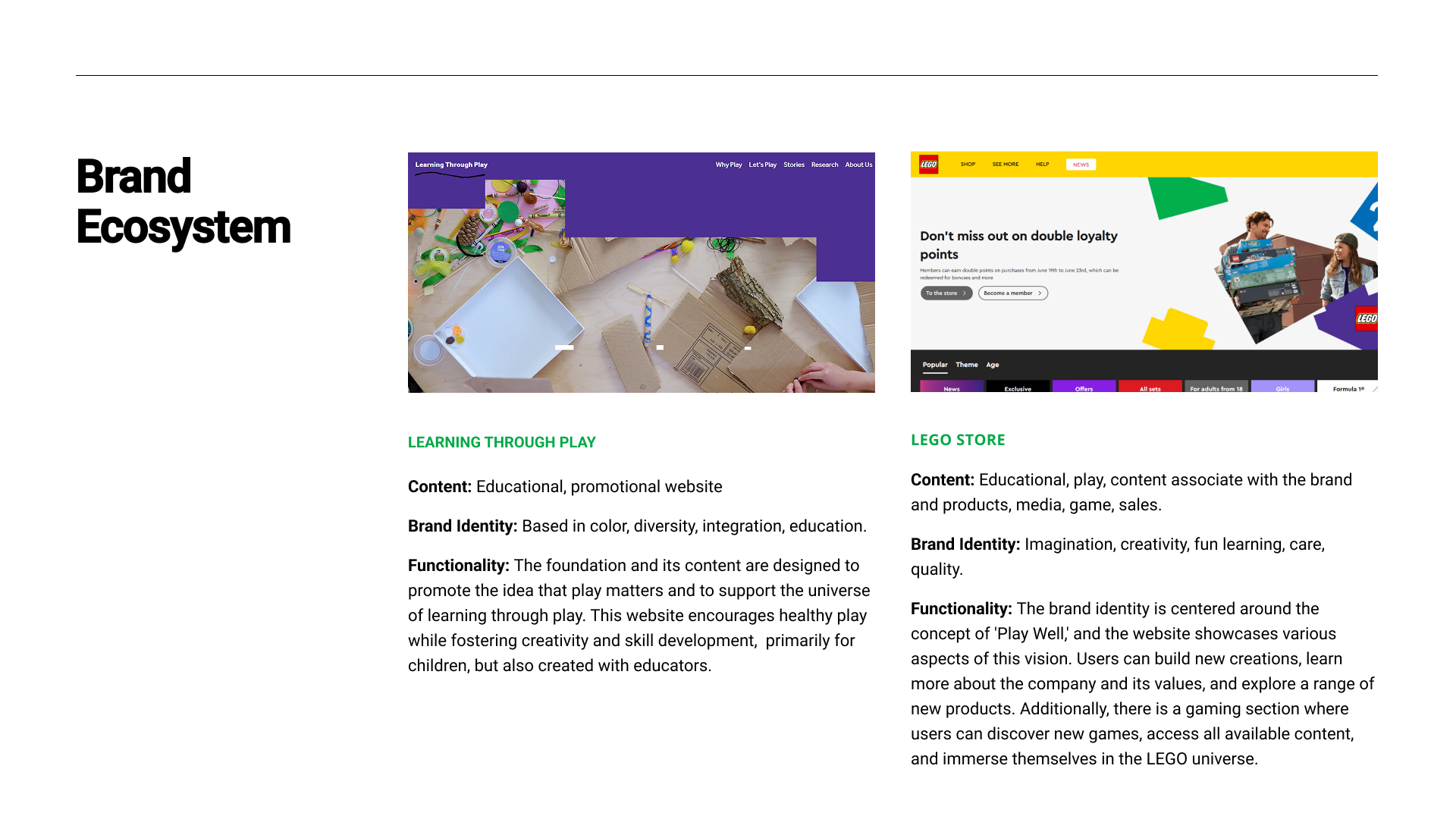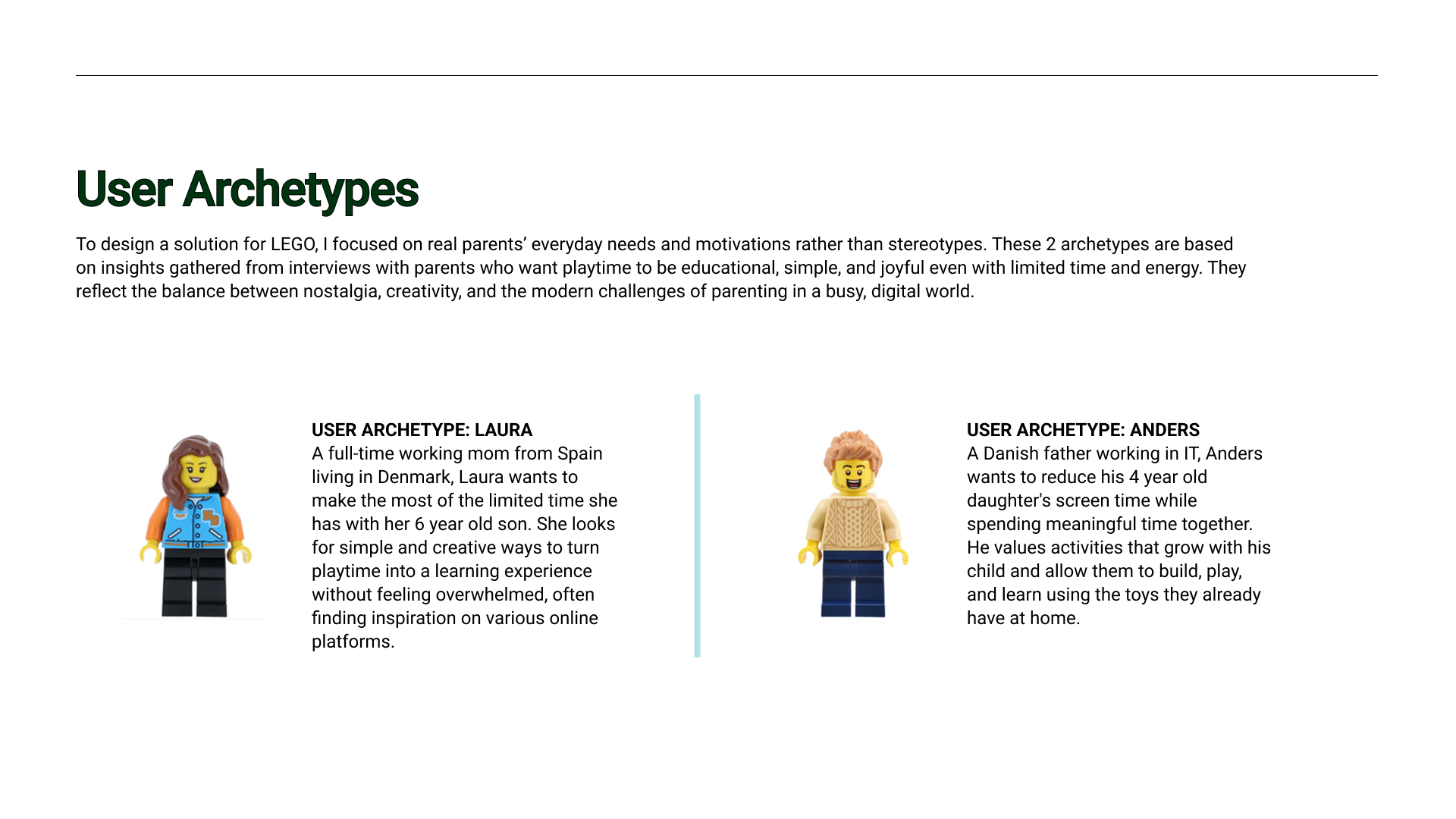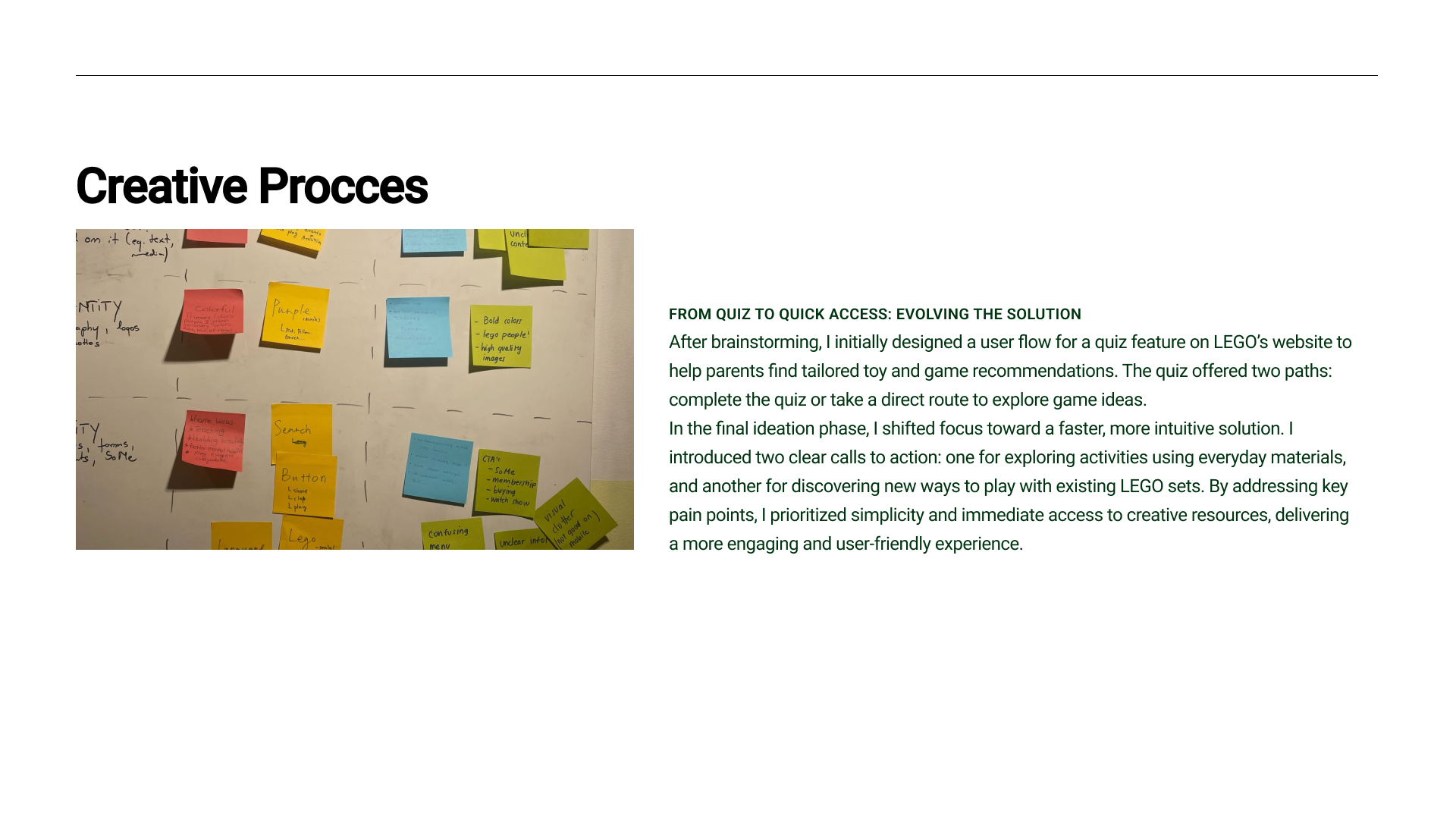Overview
Role: UX Designer, UX Researcher, UI Designer
Type: Final course project
Duration: 12 weeks
Tools: Figma, FigJam, Google Forms, Miro, Illustrator, Teams, Zoom
Objective: LEGO’s e-commerce platform offers a world of products, while the LEGO Foundation promotes Learning Through Play, yet these two experiences exist separately. This project aimed to creatively connect product selection with educational purpose, enhancing the LEGO experience while promoting the foundation’s values.
Goal: Design a user-centered solution grounded in research and surveys to help parents find educational value in LEGO purchases while making playtime more meaningful. To demonstrate and validate this solution, develop and test an interactive prototype that connects LEGO product selection with educational play suggestions, allowing users to interact with the concept and provide feedback.
As a first step, I conducted thorough brand research to highlight the core values and identities of each brand involved. The target audience was clearly defined in the case as parents with children aged 3 to 11 in Denmark. To gather initial insights into their needs and challenges, I designed and launched a survey that revealed key issues and helped determine how deeply to continue the research.
Next, I carefully crafted a detailed questionnaire focused on understanding how parents play with their children: how much time they spend, which activities they prefer, how they perceive their parenting role, and how they balance their own lives with their kids’. I also explored their childhood experiences, their relationship with the LEGO brand, and, when participants felt comfortable, their relationship with their own parents. These insights formed the foundation for creating well-rounded user archetypes.
Qualitative survey insights helped validate key behavioral patterns found in interviews.
Opportunity Space
LEGO’s online store and its Learning Through Play Foundation offer incredible value, but in separate spaces. This leaves parents searching for both engaging toys and meaningful guidance without a unified experience.
Case
Design a feature within the shopping platform that reveals the learning potential behind each product, turning every purchase into an opportunity for growth.
Target Audience
Parents aged 27 to 45, with children between 2 and 11 years old, LEGO fans who shop both in Denmark and internationally.
Challenge
How might we introduce learning information in a way that feels natural, inspiring, and fun; true to the spirit of LEGO?
Solution Space
Empower parents to see the learning value behind LEGO products, making playtime both joyful and meaningful.
Research Summary
From the start, I understood that unlocking a meaningful solution meant stepping into parents’ shoes, not just examining what they buy, but how they experience playtime in real life.
The research revealed a powerful insight: many parents don’t lack the will to play, but rather the time and energy. After long workdays, what they truly want is to make those short moments of play count—sharing fun, connection, and learning in effortless ways.
This insight highlighted a clear opportunity: create a space within LEGO’s shopping platform that inspires parents with simple, educational play ideas using LEGO products, mixed materials, or toys they already own.
The goal was to guide parents toward engaging activities while subtly linking these ideas to relevant LEGO sets, allowing them to explore creative play and easily add new sets if inspired.
User flow
Design Process & Prototype
The process began with hand drawn sketches, which helped me quickly explore initial concepts and placements for the Learning Ideas CTA and potential access points within the LEGO website. These early sketches guided the creation of low-fidelity wireframes, where I started mapping possible interactions and filter placements.
As ideas evolved, I developed medium-fidelity wireframes that allowed me to better visualize how the new section could fit seamlessly into an existing page without disrupting the user experience. This stage was key to balancing visibility and subtlety.
Finally, I crafted high-fidelity wireframes that refined the layout, interaction details, and visual hierarchy. These wireframes served as the foundation for an interactive prototype, bringing the concept to life and enabling user testing and feedback.
HIGH WIREFRAMING/PROTOTYPING
Filters in "Discover engaging activities using everyday materials":
These filters help parents tailor their search by selecting criteria such as the child’s age, number of participants, educational goals, materials they want to include, and the desired duration. By adjusting these filters, users can easily find activities that best fit their needs and context.
“Spread Fun” appears after each described activity. This review feature allows parents to rate the activities, helping recommend the best ones based on user ratings and providing other users with a trustworthy reference grounded in real experiences.
When parents step into the Learning Ideas section for the first time, they’re greeted with two inviting paths. The first, “Discover engaging activities using everyday materials” sparks the idea that play doesn’t need to be complicated. The second, “Unlock creative possibilities with your LEGO sets” invites parents to see familiar bricks in a new light.
These sections are designed to unlock inspiration for parents, meeting them where they are, whether it’s with a simple box of LEGO bricks or everyday items around the home. With just a few clicks, they can discover playful activities that transform moments into opportunities for creativity, connection, and learning.
Filters in “Unlock creative possibilities with your LEGO sets”:
This section offers filters such as age, number of participants, duration, skills to develop, materials, and specific LEGO sets required for each activity. These options allow parents to quickly find the most suitable and inspiring ways to play with the LEGO bricks they have on hand.
Testing Phase
To validate the prototype, I conducted usability testing with five participants: 3 in person interviews and 2 virtual sessions. Observing users interact with the prototype firsthand revealed valuable insights about navigation flow, filter usability, and overall experience. This hands on feedback highlighted opportunities for enhancing fluidity and simplifying interactions, especially around filter design. The testing phase was essential to refine the prototype before finalizing the design, ensuring it meets real user needs in a natural and intuitive way.
Following usability testing, I used a prioritization matrix to evaluate potential improvements by balancing their impact against the effort required. This strategic approach helped focus on changes that would maximize user benefit while keeping development efficient. It ensured that enhancements to navigation, filter design, and content placement were thoughtfully planned and effectively implemented.
Conclusions
This project tackled parents’ main challenges by blending simplicity with playful engagement. As a result we find a streamlined way for parents to quickly uncover creative play ideas on LEGO’s site, all while showcasing the Learning Through Play Foundation’s inspiring values.
Users loved personalized filters that connected directly to educational content, but there’s room to make navigation clearer and interactions smoother. Showing how LEGO sets boost both learning and fun could spark even more excitement.
Looking ahead, adding social sharing and weaving content deeper into the experience opens doors to build a lively, creative community. By focusing on popular filters like age, materials, and skills, the platform can deliver truly tailored play inspiration that meets each family’s unique needs.
LEGO
Featuring LEGO and Learning Through Play: Educating Parents and Kids in the Universe of Play
In Summary
This project strikes a thoughtful balance between simplicity and meaningful engagement, guided by real user insights. It seamlessly integrates educational content into the LEGO shopping experience, empowering parents to discover creative play ideas effortlessly. There’s still plenty of room to explore, research, and play with these values — opening exciting possibilities to expand and deepen the concept even further.















